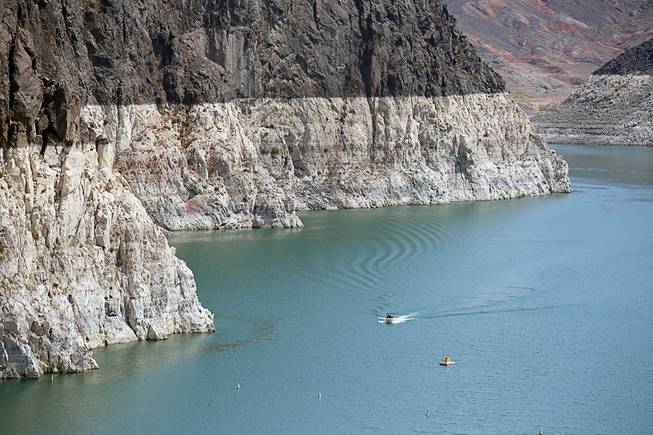
A boater on Lake Mead travels by the bathtub ring near Hoover Dam Thursday, July 15, 2021.
Monday, Feb. 26, 2024 | 2 a.m.
Lake Mead’s water elevation climbed back to 2021 levels this month thanks to winter precipitation and resulting snow melt, but experts stress the challenges of managing the region’s water supply remain because of the hotter, drier climate that’s been persistent in the ongoing drought in the Western United States.
The lake’s surface reached 1,075 feet above sea level last week, according to the website lakelevels.info, to return to levels not seen since May 2021, when they measured at 1,073 feet.
Water cuts and the unusually heavy snowfall last winter helped the lake rally, said Bronson Mack, a spokesman for Southern Nevada Water Authority. But, he stresses, the higher water levels aren’t projected to last.
“We could see about a 20-foot swing in elevations this summer,” he said.
Some 40 million people from Denver to Mexico, including many farmers, depend on the 1,450-mile-long Colorado River for water. The river feeds into Lake Mead, where the retreating water levels are obvious with a bathtub ring showing where the water previously reached.
The race against climate change doesn’t give much time to refill reservoirs at Lake Mead and Lake Powell, experts say. Lake Mead reached its lowest level at 1,040 feet above sea level in July 2022.
Kim Mitchell, senior water policy adviser at Western Resource Advocates, warned last summer at the peak of the triple-digit temperature days in cities like Las Vegas and Phoenix that “it only takes a few dry years to set us back.”
A 24-month projection by the Bureau of Reclamation estimates the lake’s level can only match its current height through December 2025, based on the river’s hydrology, soil moisture conditions and historic data. Mack said the water authority used those projections, but they’re less reliable the further they project into the future.
“Once we get out into Year Two, I always take a couple of beats,” Mack said.
Unusually heavy snowfall in winter 2022-23 boosted the Upper Colorado River Basin’s snowpack to more than 150% of its historic average. Unusually high runoff poured from the Rocky Mountains, Sierra Nevada Mountains and other mountain ranges into the Colorado River Basin through spring and summer of those years.
According to the Natural Resources Conservation Service, a U.S. Department of Agriculture office that tracks snowpack development, snowpack this winter in the Upper Colorado River Basin is close to 100% of its 30-year average, meaning the snowmelt won’t be nearly as dramatic moving forward. But Mack said snow doesn’t start melting until mid-April, making precipitation harder to predict. “We could see a 2023 snowpack again,” Mack said. “It remains to be seen.”
Even if the snowpack rises above its average, dry soil in the river basin due to more than 20 years of ongoing severe drought in the western United States could swallow up part of the excess. The National Oceanic and Atmospheric Administration’s soil moisture data for November 2023 showed average or above-average soil moisture in parts of the Upper Colorado Basin where runoff is typically heaviest, but below-average soil moisture in the Lower Colorado Basin.
“Basins with above-average soil moisture conditions can be expected to experience more efficient runoff from rainfall or snowmelt while basins with below-average soil moisture conditions can be expected to have lower runoff efficiency until soil moisture deficits are fulfilled,” the Colorado River Basin Forecast Center stated in a report last week. “The timing and magnitude of spring runoff is ultimately a result of snowpack conditions, spring weather and soil moisture conditions.”
Nevada has 279,000 acre-feet of water available from the river in 2024, a 7% cut from 2023, although it traditionally has not used its full allotment because of conservation efforts and recycling water used indoors.
Southern Nevada used 224,000 of its 300,000 acre-foot allocation from Lake Mead last year, the water authority previously said.
Earlier this year, Arizona, California and Nevada released a plan to conserve an additional 3 million acre-feet of water through 2026 in exchange for $1.2 billion from the federal government. An acre-foot of water is about 326,000 gallons and enough to serve two to three households annually.
The plan, which still needs to be finalized, would mean cuts for California’s Imperial Irrigation District, the largest user of Colorado River water. The district, which supplies farmers who grow fruits, vegetables and feed crops, is typically spared based on senior water rights.
Guidelines that dictate how Colorado River water is allocated expire in 2026, but federal authorities continue to caution that the available water is over-allocated.
Discussions among states, tribes and the federal government about their priorities for the river after 2026 are ongoing.
